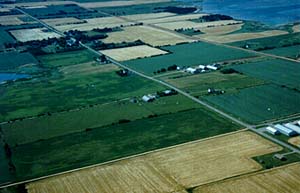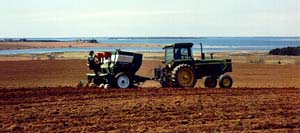








 The
family farms which dotted the countryside practiced what
is known as 'mixed farming.' While most modern farmers
specialize in one agricultural sector, such as potatoes
or dairy, their predecessors kept a wide array of farm
animals and planted many different field crops. Their
fifty to one-hundred acre operations-- small by modern
standards-- were remarkably self-sufficient, producing
the meat and vegetables for the family and all the grain and hay
required by the livestock. Barring a poor year in any
single area of the farm, it could sustain itself without
all that much money changing hands.
The
family farms which dotted the countryside practiced what
is known as 'mixed farming.' While most modern farmers
specialize in one agricultural sector, such as potatoes
or dairy, their predecessors kept a wide array of farm
animals and planted many different field crops. Their
fifty to one-hundred acre operations-- small by modern
standards-- were remarkably self-sufficient, producing
the meat and vegetables for the family and all the grain and hay
required by the livestock. Barring a poor year in any
single area of the farm, it could sustain itself without
all that much money changing hands.
There was a natural cycle to things within the mixed farm, where the products-- or even waste-- from one sphere of activity would find some useful purpose in another. Cattle produced the beef, milk, and butter needed by the family, as well as furnishing the farmer with disposable income when he sold milk to the local cheese factory. Of course, keeping the animals in the barn all winter resulted in huge piles of manure, but even this smelly byproduct proved an unlikely godsend to the farmer when it came time to fertilize his fields. Because they absorb many nutrients from the soil, potatoes should be grown in a field only one out of every three years. The best crop rotation for re-oxidizing the land is to plant clover and then hay in the intervening two seasons. This three-year crop rotation was perfectly in line with the practices of the mixed farmer, as he needed the clover for his cattle and the hay for bedding in the barns. And once this hay was soiled in the stalls, it went back on the land-- and the cycle continued.
 The rise of
mechanization and chemical fertilization dramatically
changed farm practices on Prince Edward Island. These new
methods led to marked increases in production, a new
emphasis on commercial ventures, and a greater concern
with industry standards. With an expanded export market,
the government began to make inspection compulsory for
seed and table potatoes. If these inspectors found a
foreign variety in a field, the farmer had to weed it out
or his entire field would be turned down. One local
anecdote tells about a farmer who was removing a foreign
strain from his field, and was asked by a passer-by about
what he was doing. Grumpily, he responded that he was
'picking the tourists out of his potatoes.' Islanders
have always been quick to spot a come-from-away, both in
terms of people and potatoes.
The rise of
mechanization and chemical fertilization dramatically
changed farm practices on Prince Edward Island. These new
methods led to marked increases in production, a new
emphasis on commercial ventures, and a greater concern
with industry standards. With an expanded export market,
the government began to make inspection compulsory for
seed and table potatoes. If these inspectors found a
foreign variety in a field, the farmer had to weed it out
or his entire field would be turned down. One local
anecdote tells about a farmer who was removing a foreign
strain from his field, and was asked by a passer-by about
what he was doing. Grumpily, he responded that he was
'picking the tourists out of his potatoes.' Islanders
have always been quick to spot a come-from-away, both in
terms of people and potatoes.
In the 1950's, many of the traditional mixed farms began to specialize, leading to a greater proportion of large-scale operations within the agricultural sector. By the end of the 1980s, over half of the remaining 3,000 farms were defined as commercial enterprises. The average size of a farm had doubled within the space of a generation. With the arrival of large potato processing plants, such as the Irving-owned Cavendish Farms, farmers continue to increase their crop production to meet the demand. Now, some Island potato farmers cultivate upwards of 600 acres of potatoes in a single season.
